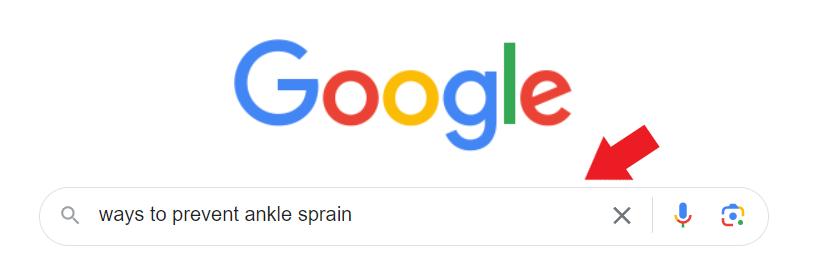Table of Contents
ToggleWhat is Search Engine Optimization (SEO)?
Search Engine Optimization (SEO) refers to the process of improving the quality of your podiatry website so that it ranks high on relevant search queries. It has three types which are On-page SEO, Off-page SEO, and Technical SEO.
On-page SEO is when you work on improving the quality of your website so that it ranks high on the Search Engine Results Page (SERP) while Off-page SEO is when you improve the quality of your website by making efforts that are outside your website like guest posting or through social media marketing.
Lastly, Technical SEO is when you focus on improving the technical aspects of your podiatry website so that it ranks high on relevant search queries (e.g. fixing broken links or making your site mobile-friendly)
Want to learn more about how SEO can help you stay on top of the minds of your potential patients?
SEO for Podiatrists
One of the main reasons why you should consider SEO for podiatrists is that it can help you rank high on relevant search queries. With the use of the right keywords and optimization strategies which we will share with you in a bit, your podiatry clinic will have better chances of reaching out to your potential patients.
Not only that, but SEO can also be helpful in improving the credibility of your podiatry clinic. When your target audience sees that your podiatry website shows up whenever they search for valuable information about their foot problem, it can be a factor that will help establish their trust in your business.
Want to start SEO with your podiatry clinic?
SEO Strategies for Podiatrists
Now that you have a background of what SEO is and how your podiatry clinic will benefit from it, we’ll proceed with tips on how you can optimize your website to improve your rank on relevant search queries.
On-page SEO techniques
In this section, you’ll learn tips on how you can optimize your podiatry website so that you can outrank your competitors.
1. Optimize your title tags, meta descriptions, and headings
Title tags can be seen in places like on the Search Engines Results Page (SERP) (as clickable headlines) and on top of your browser’s tab. Its purpose is to give your page a name and help it get found online.
This is what a title tag looks like on SERP:

And this is what it looks like on top of a browser’s tab:
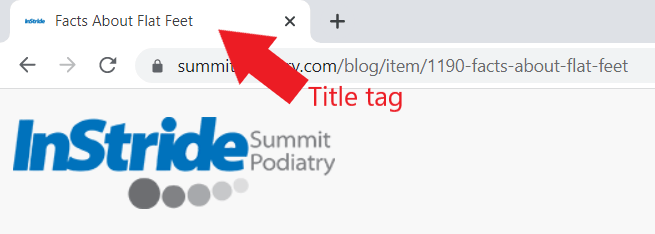
How to optimize your title tags for SEO:
- Make sure that each page on your podiatry website has a unique title tag
- Your title tags should add context to the page
- It should start with your focus keyword
- Should have power words
- Should have a positive/negative statement
- Recommended title tag length: 50-70 characters
Meta descriptions, on the other hand, are the short description that you usually see under the headlines on search engines. It gives your target audience a brief overview of what your page is all about.
This is what it looks like on SERP:

Tips for optimizing your meta descriptions for SEO:
- It should include your exact primary keyword
- Write it in a compelling manner to get more clicks
- Keep it between 155-160 characters so that it won’t get cut off in the middle
- It should be the same at the beginning of your content (so that Google gets used to it)
Headings make your content readable. This divides your blog into different sections which makes it easier for page visitors to skim your content and jump right to the part that they are looking forward to reading about.
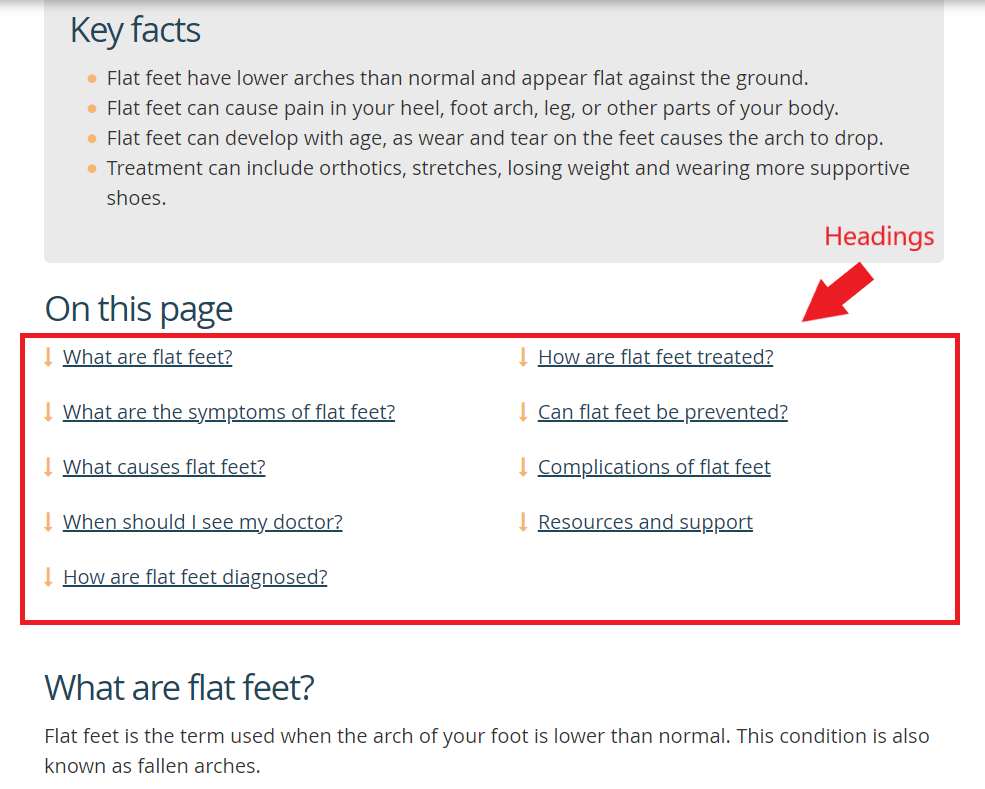
Tips for optimizing your headings for SEO:
- Use variations of your target keyword (e.g. LSIs, synonyms, or secondary keywords)
- Keep your headings brief
- Don’t keyword stuff your headings
- Headings should match search intent (this might give you a chance to
2. Optimize your page URL slugs
URLs consist of letters that lead your target audience to your podiatry website. URL slug, on the other hand, comes right after your domain name (e.g. https://podiatry.com/foot-ankle-specialists). Its purpose is to help search engines and page visitors understand and get a gist of the content of your page.
Tips for optimizing your URL slugs for SEO:
- keep your URLs short but easy to read
- don’t use the current year on your URLs
- make sure that each page on your podiatry website has unique URLs
- avoid using unnecessary characters like random numbers and symbols
- should include your target keyword
- use hyphens to separate words
- stick to lowercase characters
- don’t use the current year (it may look outdated if you forget to change it as the years pass by)
3. Use relevant keywords in your content
Keywords help you get your podiatric content get found online. With that, you have to make sure that you do comprehensive keyword research before you start creating content for your target audience.
How to do manual keyword research:
- On your browser, type the keyword that you want your podiatry blog to rank for.

- Check each article on the search results page to see how many times the keyword was used, other variations of it, along with its keyword placement throughout the content.

- Press Ctrl +F followed by the main keyword you plan to use on your podiatry blog. This will give you an idea of how many times a keyword was used along with the keyword placement that your competitors use.

From there, you’ll have an idea of what keyword variations to use in your podiatry blog posts which will be helpful in improving your site’s online presence.
Here are some tools that can help you in finding relevant keywords for your podiatry content:
- Browser Extensions
- If you want to immediately see relevant keywords that you can use on your blog posts or landing pages, Keywords Everywhere allows you to see related keywords, search terms that people with the same intended use, long-tail keywords, and a lot more!
- Google Ads Keywords Planner
- If you have an ongoing ad campaign, another platform where you can discover relevant keywords and see forecasts of how they perform is the Google Ads Keyword Planner. This will give you lots of data about your target keyword such as the average monthly searches, keyword competition, top-of-the-page bids, and a lot more! You can even refine the suggested keywords (e.g. branded or non-branded keywords, based on the region, and others).
- Google’s autocomplete suggestions
- The autocomplete suggestions consist of predictions about relevant search queries based on a term used by someone using the search box. These suggestions are based on (1) the language used and (2) the location of where the search query came from.
- Google’s related searches section
- The related searches section can be found on the bottom portion of Google’s Search Results Page. Just like auto-complete suggestions, this also contains relevant search queries that your potential patients use.
4. Content marketing

Content marketing is when you share relevant information about your podiatry services in the form of images, videos, blog posts, podcasts, and other types of content. Its purpose is to establish your expertise as a podiatrist, build your authority in the industry, and at the same time, it can help you stay on top of the minds of potential patients whenever they are ready to engage themselves with your podiatry clinic.
Tips when creating content for your podiatry website:
- create content for each stage of the buyer’s journey
- readability level should be grade 8 or below (use Hemingway App to check)
- regularly post podiatry-related content
- always proofread before publishing
- don’t use medical jargon, instead use simpler terms to explain a condition
- repurpose your old blog posts
- when creating infographics, share them on Pinterest to get an additional source of traffic
5. Use internal and external links on your posts
Internal links are used if you have pages on your podiatry website that explains a topic. On the other hand, external links are pages that explain a topic in your content which can be found on other websites. Using these kinds of links on your content helps search engines and crawl bots get a better understanding of what your page is all about.
Tips when using internal links for SEO
- use keyword anchor texts
- don’t use too many internal links
- add internal links to add context to your content, not spam your page visitors
- make sure it’s relevant to the topic of your page
- link to important pages on your podiatry website
Tips when using external links for SEO
- make sure that external links will open to a new tab
- only link to trusted websites
- from time to time, check the external links you use on your previous blogs (some might be dead links)
- use keyword anchor texts
6. Make your podiatry website mobile-friendly
65% of global traffic comes from mobile devices. With that, you have to make sure that your podiatry website is not just usable for desktop users but even for mobile users. You don’t want your page visitors to leave your site without taking action because the font size is too small or pop-ups are not automatically scaled for mobile devices.
To test if your podiatry website is mobile-friendly, use this Mobile-friendly test. You just have to enter the URL of your podiatry website and click “Test URL.” 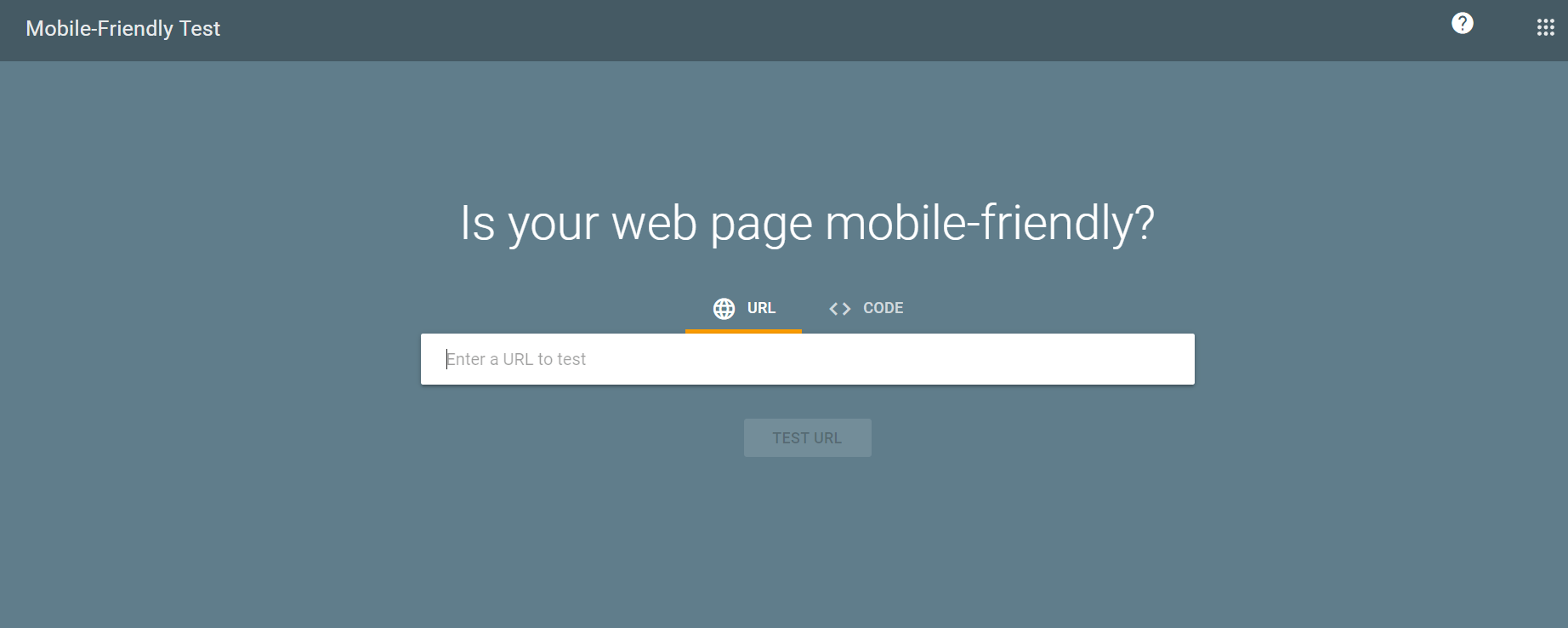
Then, you’ll see the test results after a minute or two.

Need help optimizing your podiatry website?
Off-page SEO techniques
In this section, we’ll share tips on how you can improve the quality of your podiatry website through off-page SEO.
1. Guest posting

One of the most effective off-page SEO techniques is by publishing a blog on other websites. The purpose of guest posting is to help increase your domain authority by getting high-quality backlinks. Aside from that, through this guest blogging opportunity, you’ll start building relationships with other companies, improve your brand awareness, and get referral traffic.
Keywords that will help you find guest posting opportunities:
- [topic that you want to write about] + write for us
- [topic that you want to write about] + become a contributor
- [topic that you want to write about] + guest article
Tips when writing guest posts:
- make sure to follow their guest posting guidelines
- use internal links through your blog, so they’ll have an idea that you’re familiar with the content they frequently post
- after publishing, track the performance of your post
- promote your content on other platforms
- your bio should include a brief description of yourself, a professional yet casual photo of yourself, a statement that can help build your credibility (e.g. founder of the podiatry clinic or a relevant award that you received), and channels where page visitors can engage with you.
2. Post on social media

Social media marketing is when your share relevant content about your podiatry services on social platforms like Instagram and TikTok. This marketing strategy works best especially if your goal is to improve brand awareness, build a community, and keep in touch with your target audience.
Social media marketing best practices
- use relevant hashtags on your posts
- A/B test your captions (e.g. length, emojis, and hashtags used)
- be consistent in posting
- engage with your target audience
- respond to patient reviews
- leave a comment under relevant posts
- re-share tagged posts or user-generated content
3. Get listed in online directories
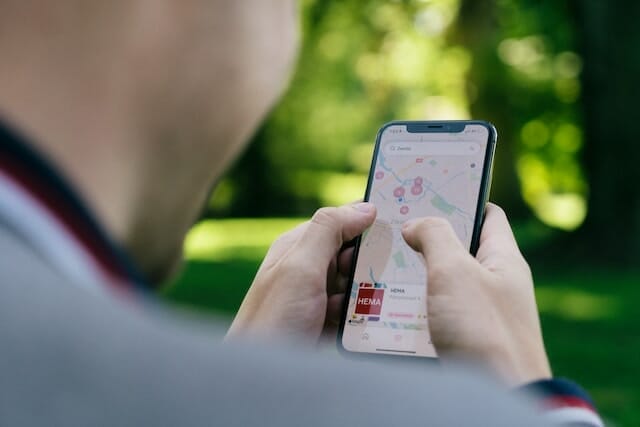
Online business directories help you get found online. Yelp, Google My Business, and Healthgrades are some of the business directories where you should have your podiatry clinic listed. With an optimized business listing, you’ll have higher chances of ranking on the local map pack which will result in more phone calls, direction requests, and appointment bookings!
Tips on how to optimize your online listing:
- make sure that essential details about your podiatry clinic are consistent across all platforms
- regularly update your business hours
- respond to questions raised by potential patients
- monitor your reviews
- keep your notifications on for new questions, answers, and reviews on your listing
Check out our blog about Google My Business for Podiatrists to learn more tips on how you can optimize your business listing.
4. Participate in online forums

Quora and Reddit are some of the online discussion forums where people talk about topics that are relevant to your podiatry services. What’s great about joining community discussions is that you can share your expertise by expressing your thoughts and opinions about a certain topic. You can even add a link to one of your blogs if you want to provide a more comprehensive explanation of the topic.
Tips when participating in online forums:
- don’t use affiliate links (especially on Quora) your account might get suspended or banned for it
- online add relevant links to your podiatry website when applicable
- follow the guidelines of every online discussion platform that you join
- it’s all about establishing your credibility as a podiatrist, so make sure that you answer relevant questions professionally
5. Video Marketing

Another off-page SEO strategy is by promoting your podiatry services in video format. As of 2023, 91% of businesses use videos as a tool in marketing their products and services. What’s great about this technique is that it’s shareable, can help you get more traffic, and at the same time, can help your rank high on SERP.
Here are the elements that your videos should have:
- your video should tell a story
- keep it short
- include a strong call to action
- high-quality video
- intro that hooks the attention of your viewers
Tips that can help you create an effective video marketing strategy
- be consistent in posting (have a posting schedule)
- monitor the performance of your marketing videos
- most people watch videos with the sound off, with that, consider adding captions or subtitles to your videos
- make sure to use the recommended video dimensions for each platform
- test the length that works for you
Technical SEO techniques
After learning the tips on how you can improve the rank of your website through off-page SEO, in this section, you’ll find out more about the technical aspects that can be improved in your podiatry website.
1. Optimize your landing pages

Landing pages are where page visitors “land” after clicking your website from the search results page. The reason why you should optimize your podiatry clinic’s landing pages is that it increases the number of conversions you have on your site. When done right, it can help you get more new patients!
To have better chances of converting a page visitor into one of your podiatry clinic’s patients, here are some tips that you can do:
- A/B test your headlines
- Your headlines should briefly tell how your podiatry services can help potential patients have a better life
- Include a clear call to action
- Provide a relevant offer
- Add a sense of urgency to your offer
- Include patient testimonials, professional certificates, or awards you got as a podiatrist
- Use colors that match the color scheme of your podiatry clinic
- Compress large image file sizes before uploading them to your site
2. Improve your page loading speed

Page loading speed matters (a lot less than people think it matters but it still matters a little). Especially if you want your future patients to stay longer on your podiatry website.
The longer the page loading time, the higher the bounce rate.
Use the eye test though because some of the tests like PageSpeed Insights are pretty inaccurate.
If you go to a site itself, it’ll load the site fast but on PageSpeed insights it’ll say it’s slow. It’s because PageSpeed insights use the largest contentful paint which for a lot of sites, loads most of what users see immediately and has a few hidden things that they load later.
A lot of speed tests are inaccurate because it is based on the last hidden thing that loads in when that doesn’t affect user behavior or bounce rate. Different speed tests have their own definition of “contentful paint” and a site might load to what your eye sees as fully loaded but to the speed test it’s not “contentful paint”. This is why you’ll see a lot of sites that are slow according to speed tests but have no problem ranking.
This is also why some people game the speed tests and just have something random thing load fast to hit the “contentful paint” checkmark but in reality actual site loads really slowly.
Use the eye test.
3. Use proper alt tags
Alt tags also called “alt texts”are brief descriptions of the images used on your podiatry page. This helps individuals with visual impairments to get a gist of what your images are all about. It can also be helpful whenever the images you used fail to load.
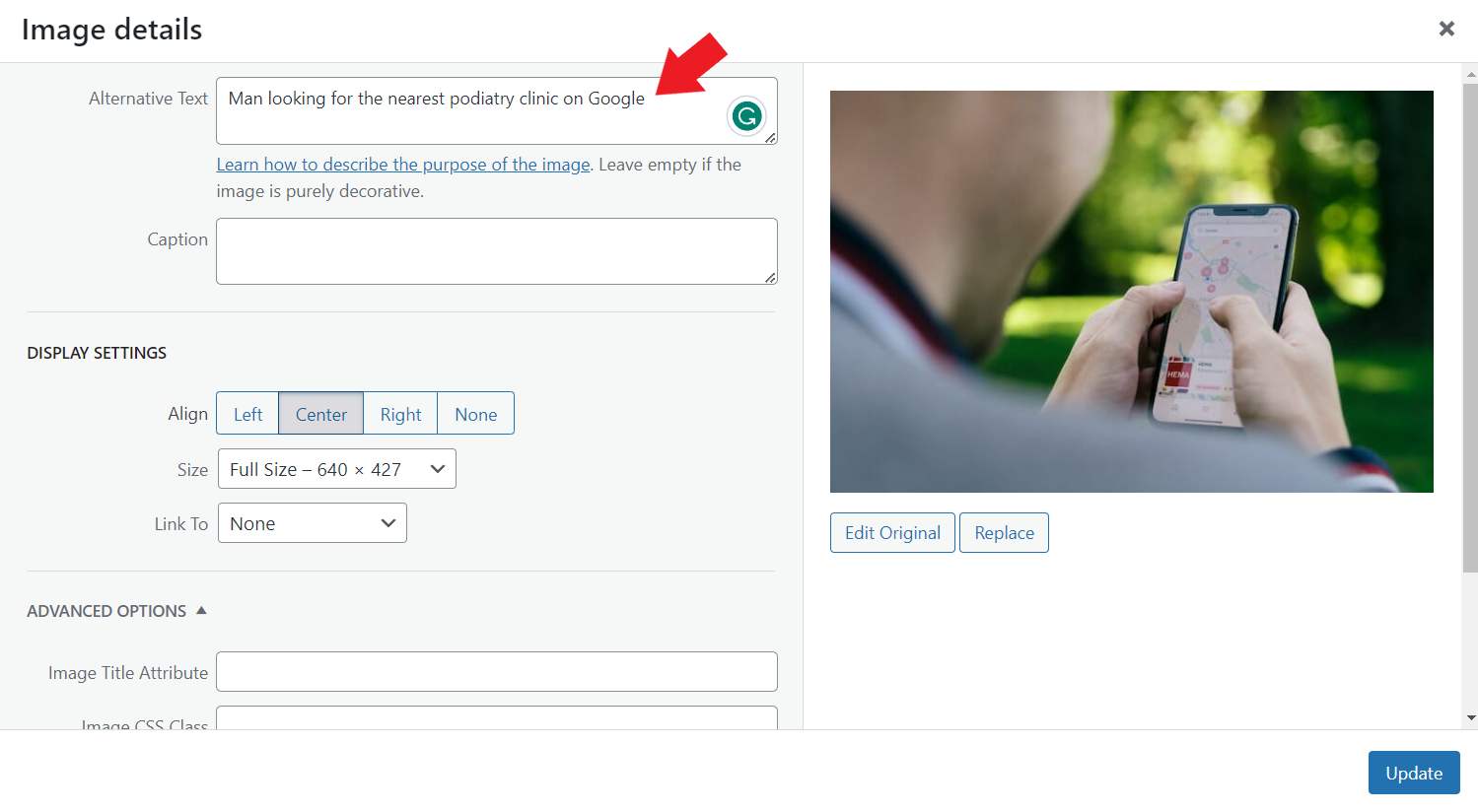
Tips when writing your alt tags:
- should be specific
- should add context to what you’re talking about
- keep it short (125 characters or less)
- add your focus keyword (but don’t spam your alt tags with too many keywords)
- proofread to prevent confusing search engine crawlers
With the use of proper alt tags, you can help provide a better user experience to your page visitors.
4. Fix dead links

Deadlinks refer to pages on your podiatry website that are either deleted or moved to another location. Having lots of dead links on your site is bad for SEO.
One of the reasons why you should regularly scan your website for deadlinks is that it will lead to frustrated visitors. When people click on a link that brings them to a page that is blank or is no longer there, they are more likely to leave that page and look at other websites instead.
To prevent losing valuable traffic on your podiatry website, use Google Search Console. Not only will it provide you with dead links but it will also give you an idea of the issues that you might want to fix on your site (e.g. indexing issues).
5. Check your website for duplicate content
Duplicate content is when you have the same content on different pages on your podiatry website. Having duplicate content on your website can cause problems to your website which include negatively affecting your SEO efforts.
This is because when your page has several pages that have almost the same content, it makes it hard for search engine crawlers to decide which page should rank high. This will result in the other page losing potential traffic and will hurt your rank on search engines.
You can use Semrush to check which pages on your podiatry website rank for the same keyword, get real-time performance reports, and identify what rank you are on search engines like Google, Bing, Yahoo, and YouTube!
6. Make sure your website is secure

Last but definitely not least, you have to make sure that your podiatry website has an encrypted connection. Google favors websites that provide a secure connection compared to those that don’t. So, if your website is still using HTTP:// instead of HTTPS://, you might want to install an SSL certificate on your web hosting account.
Unsecured websites drive potential patients away from your business. Not just that, but with an unsecured connection, your patient’s personal information (e.g. credit card details, login details) might be stolen by third parties.
Things to do after switching from HTTP:// to HTTPS://
- Set up 301 redirects to HTTPS://
- 301 redirects are mainly used if you have pages on your podiatry website that have permanently moved to another URL. Its purpose is to send page visitors who visited your old link to the new one.
- Make sure that internal links are switched from HTTP:// to HTTPS://
- Go through each page on your podiatry website and check to see if the redirects are working. When internal links are clicked, they should be redirected to the new URL of your website.
- Update your XML Sitemap
- An XML sitemap containing the links of the essential pages on your podiatry website. You should update this so that search engine crawlers can find your pages especially since you migrated to a new URL.
- Make sure that everything is working properly
Want to promote your podiatry clinic through ad campaigns? Check out our blog about Google Ads for Podiatrists to learn more.
Key takeaway
Search Engine Optimization is a continuous process. Although it takes time before you see results, using the right strategies can help you achieve long-term success.


